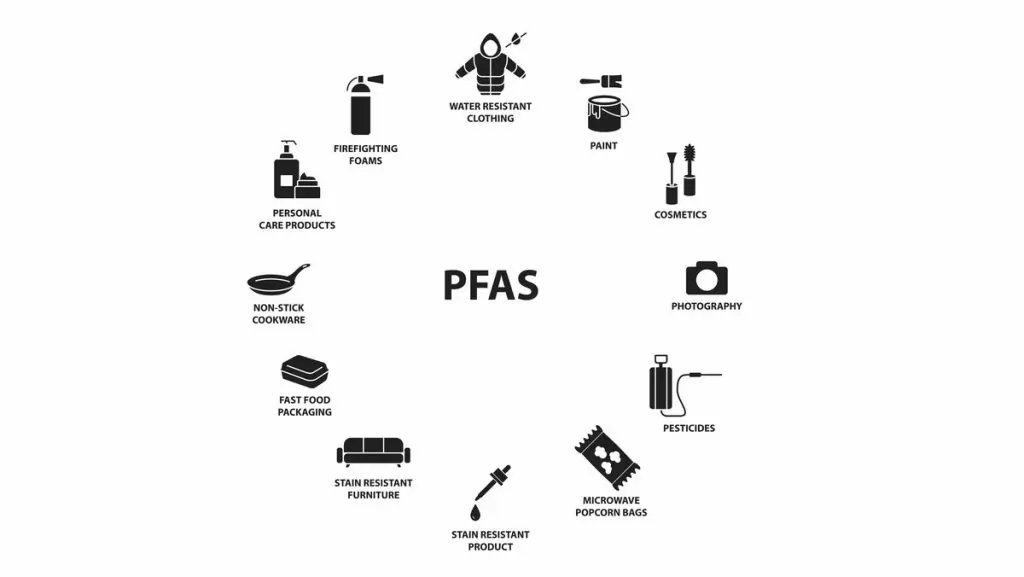Das Jahrhundertgift PFAS
Gerade scheinen sie in aller Munde (uups!): PFAS – Per- und polyfluorierte Alkylverbindungen. Die ARD-Sendung Panorama berichtete am Donnerstag, 29.9.22 um 21.45 unter der Headline „Das Jahrhundertgift“ und fragte, warum diese Chemikalien überhaupt noch erlaubt seien.
(https://programm.ard.de/TV/Programm/Sender/?sendung=281064000778195)
PFAS sind industriell hergestellte Stoffe, die sowohl Wasser, Schmutz als auch Fett abweisen und unterschiedlichen Temperaturen standhalten können. Sie kommen vor allem in Industrie- oder Verbraucherprodukten zum Einsatz und sind in Antihaftbeschichtungen ebenso enthalten, wie in Funktionskleidung, Kosmetik und Löschschaum. Doch einmal in der Welt, gelten sie als nahezu unzerstörbar, reichern sich in der Natur an und verursachen enorme Schäden. Bereits in geringsten Mengen sind sie extrem gesundheitsschädlich und können verschiedene Arten von Krebs, Hormonerkrankungen sowie Geburtsschäden verursachen. Ähnlich wie Mikroplastik finden sich PFAS überall, nachgewiesen inzwischen im Blut der meisten US-Bürger, in Muttermilch und selbst bei Wildtieren in der Arktis. Glaubt man den Ergebnissen einer neuen schwedischen Studie, würde selbst das Regenwasser weltweit wegen zu hoher PFAS-Konzentrationen als nicht trinkbar gelten.
Auch unser Trinkwasser enthält Spuren, da manche PFAS gut wasserlöslich sind und so ins Grundwasser gelangen. So sind manche Grundwassers-Einzugsgebiete bereits großflächig mit PFAS verunreinigt, beispielsweise in Altötting oder Rastatt. Da PFAS relativ neu entdeckte Mikroschadstoffe sind, gibt es erst seit 2020 eine Art Grenzwert, ab dem die Konzentration mit PFAS als „möglicherweise gesundheitsgefährdend“ gilt. Aufgrund der Beständigkeit der Stoffe werden die PFAS-Konzentrationen in den kommenden Jahren voraussichtlich zunehmen. Manche sprechen von PFAS als „Umweltgifte für die Ewigkeit“.

PFAS aus dem Trinkwasser entfernen
Zwar können die Verbindungen unter bestimmten Bedingungen mit einer Aktivkohlestufe in der Trinkwasseraufbereitung erfolgreich reduziert werden, doch verfügen die wenigsten Wasserwerke derzeit über eine solche Reinigungsstufe.
Das Problem lässt sich am schnellsten mit einem eigenen Trinkwasserfilter mit Aktivkohle zu Hause in den Griff bekommen. So bietet Seccua neben seinen Membranfilteranlagen auch einen Seccua Biofilter an, der mit körnigem Aktivkohlegranulat gefüllt ist. Die Schadstoffe werden dabei nicht mechanisch, sondern durch den physikalisch-chemischen Prozess der Adsorption (Bindung) aus dem Wasser entfernt, indem sich die Substanzen an der Oberfläche der Aktivkohle anreichern. Das neue optimierte Modell des Biofilters, das in Kürze verfügbar sein wird, wird ein noch größeres Aktivkohlevolumen und eine noch größere Oberfläche und damit eine noch bessere Filterleistung haben.
Wann der Filter zu wechseln ist, hängt von der lokalen Belastung des jeweiligen Leitungswassers ab, das Planungsziel sind jedoch 3 Jahre. Eine genaue Lebensdauer wird durch Tests ermittelt und ist auch vom Einzelfall abhängig, da nicht nur PFAS, sondern die Gesamtsumme aller Schadstoffe berücksichtigt werden sollte.
PFAS – the poison for the ages
They seem to be on everyone’s lips right now (oops!): PFAS – per- and polyfluorinated alkyl compounds. The German TV program ARD “Panorama” shortly reported under the headline „The poison of the century“ and asked why these chemicals are still allowed at all.
(https://programm.ard.de/TV/Programm/Sender/?sendung=281064000778195)
PFAS are industrially manufactured substances that repel water, dirt as well as grease and can withstand different temperatures. They are used primarily in industrial or consumer products and are found in non-stick coatings as well as functional clothing, cosmetics, and firefighting foam. But once in the world, they are considered almost indestructible, accumulate in nature, and cause enormous damage. Even in the smallest amounts, they are extremely harmful to health and can cause various types of cancer, hormonal disorders, and birth defects. Like microplastics, PFAS are found everywhere, now detected in the blood of most U.S. citizens, in breast milk, and even in wildlife in the Arctic. If the results of a new Swedish study are to be believed, even the world’s rainwater would be considered undrinkable due to excessive PFAS concentrations.
Even our drinking water contains traces, as some PFAS are highly soluble in water and thus enter groundwater. Thus, some groundwater catchment areas are already contaminated with PFAS over large areas, for example in German areas around the towns Altötting or Rastatt. Since PFAS are relatively newly discovered micro-pollutants, there has only been a kind of limit value since 2020, above which the concentration with PFAS is considered „possibly hazardous to health“. Due to the persistence of the substances, PFAS concentrations are expected to increase in the coming years. Some refer to PFAS as „environmental toxins for the ages.“

Removing PFASs from drinking water
Although the compounds can be successfully reduced under certain conditions with an activated carbon stage in drinking water treatment, only few water plants currently have such a treatment stage.
The quickest way to tackle the problem is with a dedicated drinking water filter with activated carbon at home. Thus, in addition to its membrane filter systems, Seccua also offers a Seccua biofilter filled with granular activated carbon. The pollutants are removed from the water not mechanically, but by the physical-chemical process of adsorption (binding), in which the substances accumulate on the surface of the activated carbon. The new optimized model of the biofilter, soon to be available, will have an even bigger activated carbon volume and surface area and thus even better filtering capacity.
When to change the filter depends on the local load of the respective tap water, but the planning target is 3 years. An exact life time will be determined through testing and is also case depended as not only PFAS, but the total sum of all pollutants should be considered.
